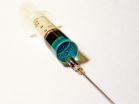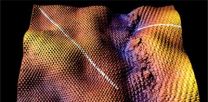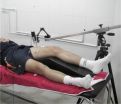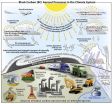(Press-News.org) CIC bioGUNE researchers have opened a new pathway for the future development of biosensors that enable measuring the glucose in the blood, but which are also believed to be more reliable with other fluids, such as urine. To this end, a complex scientific process has been developed which has called into question a dominant paradigm amongst the scientific community with respect to the mechanisms of binding and communication between proteins.
The mechanisms of communication at subcellular level are based on the interaction between proteins or between proteins and metabolites and other ligands. These phenomena help to explain the immense majority of protein functions in living organisms, but it is essential to this end that each protein knows exactly to which ligand it has to bind.
To date it has been widely accepted within the scientific community that there was a double binding mechanism between proteins, differentiated and isolated like two independent processes: some proteins bind with just one mechanism known as 'induced fit' (the protein takes the shape of the ligand during the association process), while others do so exclusively through a mechanism known as 'conformational selection' (in the same way that each lock requires a key with specific characteristics, the bind between a protein and a ligand will depend if their shapes make such a fit possible).
However, in this research, Dr. Oscar Millet, from the Structural Biology Unit at CIC bioGUNE, and published in the November issue of the Journal of the American Chemical Society, refutes this paradigm and puts forward the idea that slight modifications using genetic engineering introduced into the hinge regions between two proteins are sufficient to alter the binding mechanism itself.
For the development of this research, two bacterial periplasmic binding proteins were taken as a model. These proteins bind through a spectacular conformational change (closing two domains round a hinge region) and which is similar to the process that carnivorous plants use to trap insects between their fleshy lobes.
"The main result of our work has shown that both mechanisms are intimately connected and that we can go from one to another just by introducing small modifications in the protein," explained Óscar Millet.
"Not only have we understood this mechanism, but we have seen that the difference between this induced fit and the conformational selection is very subtle; they are actually not two independent processes – but everything is, in fact, connected. Nature is always subtle, and small variations to the chemical composition of the hinge lead us from one mechanism to the other," added the CIC bioGUNE researcher.
"This mechanism is completely governed by the hinge region to the point that by exchanging the hinges using genetic engineering, the change of mechanism also occurs: the GGBP with the RBP hinge acts through the induced fit mechanism and vice versa, and the RBP with the GGBP hinge binds to the substratum through the lock-and-key mechanism," Dr Millet explained.
"Understanding the mechanism by which periplasmic proteins trap glucose to insert it into the cells opens the possibility of using these molecules as biosensors", explained Dr Millet. Thanks to these, glucose concentration could be measured in fluids other than blood, for example urine. This would make the process easier and would provide more reliable data than the traditional glucose concentration measurement methods in the blood of diabetes patients.
The techniques currently used can only give an approximate measurement of blood glucose concentration, as there are other substances that hide it. Any advance, therefore, in the search for new diagnosis methods will improve the control of the disease.
Diabetes
It is very important for diabetes patients to measure their glucose concentration, as diabetes is a serious chronic disorder that affects more than 300 million people worldwide, and 5 million in Spain. This metabolic disease is caused by low production of a hormone – insulin – in the pancreas or when the body does not use this hormone properly. Insulin is involved in the transport of glucose to the interior of the cells, which turn it into useful energy.
In diabetics, the low generation of insulin or inadequate usage in the body leads to an excessive blood glucose concentration and causes many symptoms such as tiredness, weight loss, neuropathies, problems of vision and, in extreme cases, death.
### END
New path discovered for future generation of glucose-measuring biosensors
2013-01-15
ELSE PRESS RELEASES FROM THIS DATE:
Plumber and spray painter high-risk occupations for asthma
2013-01-15
Despite known risks and recommendations for protective equipment, many people are still affected with asthma after exposure to chemicals at work. This is the finding of an international study of 13,000 people carried out at the Sahlgrenska Academy, University of Gothenburg, Sweden.
Asthma is among the most common adult diseases in the world. Despite the fact that the risks of chemical exposure have long been known and that there are well-established recommendations for handling chemicals and protective equipment, many cases of asthma are still caused by exposure to toxic ...
How the protein transport machinery in the chloroplasts of higher plants developed
2013-01-15
Halfway between bacteria and tree
How the protein transport machinery in the chloroplasts of higher plants developed
Moss Physcomitrella patens is an evolutionary intermediate stage
Together with colleagues from Sweden, RUB researchers have studied how the protein transport system of bacteria developed over time to form the system in the chloroplasts of higher plants. They explored the so-called signal recognition particles (SRP) and their receptors. Bioinformatic and biochemical analyses revealed that the moss Physcomitrella patens has evolutionarily old and new components ...
Designer bacteria may lead to better vaccines
2013-01-15
AUSTIN, Texas — Researchers at The University of Texas at Austin have developed a menu of 61 new strains of genetically engineered bacteria that may improve the efficacy of vaccines for diseases such as flu, pertussis, cholera and HPV.
The strains of E. coli, which were described in a paper published this month in the journal PNAS, are part of a new class of biological "adjuvants" that is poised to transform vaccine design. Adjuvants are substances added to vaccines to boost the human immune response.
"For 70 years the only adjuvants being used were aluminum salts," ...
Chemistry resolves toxic concerns about carbon nanotubes
2013-01-15
Safety fears about carbon nanotubes, due to their structural similarity to asbestos, have been alleviated following research showing that reducing their length removes their toxic properties.
In a new study, published today in the journal Angewandte Chemie, evidence is provided that the asbestos-like reactivity and pathogenicity reported for long, pristine nanotubes can be completely alleviated if their surface is modified and their effective length is reduced as a result of chemical treatment.
First atomically described in the 1990s, carbon nanotubes are sheets of ...
Born to lead? Leadership can be an inherited trait, study finds
2013-01-15
Genetic differences are significantly associated with the likelihood that people take on managerial responsibilities, according to new research from UCL (University College London).
The study, published online in Leadership Quarterly, is the first to identify a specific DNA sequence associated with the tendency for individuals to occupy a leadership position. Using a large twin sample, the international research team, which included academics from Harvard, NYU, and the University of California, estimate that a quarter of the observed variation in leadership behaviour ...
Neon lights up exploding stars
2013-01-15
An international team of nuclear astrophysicists has shed new light on the explosive stellar events known as novae.
These dramatic explosions are driven by nuclear processes and make previously unseen stars visible for a short time. The team of scientists measured the nuclear structure of the radioactive neon produced through this process in unprecedented detail.
Their findings, reported in the US journal Physical Review Letters, show there is much less uncertainty in how quickly one of the key nuclear reactions will occur as well as in the final abundance of radioactive ...
New research gives insight into graphene grain boundaries
2013-01-15
Using graphene – either as an alternative to, or most likely as a complementary material with – silicon, offers the promise of much faster future electronics, along with several other advantages over the commonly used semiconductor. However, creating the one-atom thick sheets of carbon known as graphene in a way that could be easily integrated into mass production methods has proven difficult.
When graphene is grown, lattices of the carbon grains are formed randomly, linked together at different angles of orientation in a hexagonal network. However, when those orientations ...
Facebook posts not easily forgotten
2013-01-15
Facebook posts resonate significantly more with human nature than books or even human faces, according to a new study by Laura Mickes and colleagues from the University of California San Diego in the US. The difference in memory between these microblogs and actual published words from a page is as striking as the difference in memory between amnesiacs and healthy controls. The work is published online in Springer's journal Memory & Cognition.
Online social networking is very popular, and allows people to post their thoughts as microblogs, an opportunity that people exploit ...
The muscle response of footballers depends on their position on the field
2013-01-15
Football players display different muscle response parameters depending on the position that they hold on the pitch, according to a study conducted by a team of Spanish researchers which has been published in the 'Journal of electromyography and kinesiology'.
Scientists from the University of Vigo have analysed different muscle response parameters in 78 Spanish first division footballers who have been playing for between four and fifteen years. They found variations depending on the field position of the players.
Published in the 'Journal of Electromyography and Kinesiology', ...
Black carbon larger cause of climate change than previously assessed
2013-01-15
Black carbon is the second largest man-made contributor to global warming and its influence on climate has been greatly underestimated, according to the first quantitative and comprehensive analysis of this issue.
The landmark study published in the Journal of Geophysical Research-Atmospheres today says the direct influence of black carbon, or soot, on warming the climate could be about twice previous estimates. Accounting for all of the ways it can affect climate, black carbon is believed to have a warming effect of about 1.1 Watts per square meter (W/m2), approximately ...



